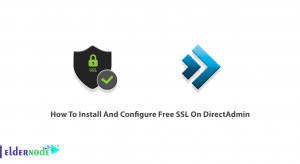
Tutorial How to secure Apache with Let’s Encrypt on Ubuntu 20.04. First, you need to Buy Ubuntu VPS with Instant Setup to learn better this guide.
Let’s Encrypt is a Certificate Authority (CA) that facilitates obtaining and installing free TLS/SSL certificates, thereby enabling encrypted HTTPS on web servers. It simplifies the process by providing a software client, Certbot, that attempts to automate most of the required steps. Currently, the entire process of obtaining and installing a certificate is fully automated on both Apache and Nginx.
In this tutorial, you will use Certbot to obtain a free SSL certificate for Apache on Ubuntu 20.04. And make sure this certificate is set up to renew automatically.
To let this tutorial work better, please consider the below Prerequisites:
1- A non-root user with sudo privileges
2- To set up, follow our Initial server setup on Ubuntu 20.04
3- A fully registered domain name. This tutorial will use your_domain as an example throughout. You can purchase a domain name on Namecheap, get one for free on Freenom, or use the domain registrar of your choice.
4- Both of the following DNS records set up for your server.
5- An A record with your_domain pointing to your server’s public IP address.
6- An A record with www.your_domain pointing to your server’s public IP address.
7- Be sure that you have a virtual host file for your domain. This tutorial will use /etc/apache2/sites-available/your_domain.conf as an example.
Table of Contents
How to secure Apache with Let’s Encrypt on Ubuntu 20.04
This tutorial uses a separate virtual host file instead of Apache’s default configuration file for setting up the website that will be secured by Let’s Encrypt. you are recommended to create new Apache virtual host files for each domain hosted in a server because it helps to avoid common mistakes and maintains the default configuration files as a fallback setup. So join us to review the steps of this guide and see How to secure Apache with Let’s Encrypt on Ubuntu 20.04.
1- How To Install Certbot
First, you need to install the Certbot software on your server, in order to obtain an SSL certificate with Let’s Encrypt. And use the default Ubuntu package repositories for that.
Also, you need two packages: certbot, and python3-certbot-apache. The latter is a plugin that integrates Certbot with Apache, making it possible to automate obtaining a certificate and configuring HTTPS within your web server with a single command.
sudo apt install certbot python3-certbot-apachePress Y, then ENTER to confirm the installation when you are prompted.
Certbot is now installed on your server. In the next step, you will verify Apache’s configuration to make sure your virtual host is set appropriately. This will ensure that the certbot client script will be able to detect your domains and reconfigure your webserver to use your newly generated SSL certificate automatically.
2- How To Checking Your Apache Virtual Host Configuration
To be able to automatically obtain and configure SSL for your web server, Certbot needs to find the correct virtual host within your Apache configuration files. Your server domain name(s) will be retrieved from the ServerName and ServerAlias directives defined within your VirtualHostconfiguration block.
To check this up, open the virtual host file for your domain using nano or your preferred text editor:
sudo nano /etc/apache2/sites-available/your_domain.confFind the existing ServerName and ServerAlias lines. They should look like this:
... ServerName your_domain ServerAlias www.your_domain ...In case you have already your ServerName and ServerAlias, set up like this, you can exit your text editor and move on to the next step. If you’re using nano, you can exit by typing CTRL+X, then Y and ENTER to confirm.
And If your current virtual host configuration doesn’t match the example, update it accordingly. When you’re done, save the file and quit the editor. Then, run the following command to validate your changes:
sudo apache2ctl configtestPlease note that you should get a Syntax OK as a response. If you get an error, reopen the virtual host file and check for any typos or missing characters. Once your configuration file’s syntax is correct, reload Apache so that the changes take effect.
sudo systemctl reload apache2When you do these changes, Certbot will be able to find the correct VirtualHost block and update it.
3- How To Allow HTTPS Through The Firewall
If you have the UFW firewall enabled, as recommended by the prerequisite guides, you’ll need to adjust the settings to allow HTTPS traffic. Upon installation, Apache registers a few different UFW application profiles. We can leverage the Apache Full profile to allow both HTTP and HTTPS traffic on your server.
Run the following command to verify what kind of traffic is currently allowed on your server.
sudo ufw statusStatus: active To Action From -- ------ ---- OpenSSH ALLOW Anywhere Apache ALLOW Anywhere OpenSSH (v6) ALLOW Anywhere (v6) Apache (v6) ALLOW Anywhere (v6)To additionally let in HTTPS traffic, allow the “Apache Full” profile and delete the redundant “Apache” profile:
sudo ufw allow 'Apache Full' sudo ufw delete allow 'Apache'You would see a status look like this:
sudo ufw statusStatus: active To Action From -- ------ ---- OpenSSH ALLOW Anywhere Apache Full ALLOW Anywhere OpenSSH (v6) ALLOW Anywhere (v6) Apache Full (v6) ALLOW Anywhere (v6)
4- How To Obtain An SSL Certificate
Since the Certbot provides a variety of ways to obtain SSL certificates through plugins, the Apache plugin will take care of reconfiguring Apache and reloading the configuration whenever necessary. To use this plugin, type the following:
sudo certbot --apacheThis script will prompt you to answer a series of questions in order to configure your SSL certificate. First, it will ask you for a valid e-mail address. This email will be used for renewal notifications and security notices:
Saving debug log to /var/log/letsencrypt/letsencrypt.log Plugins selected: Authenticator apache, Installer apache Enter email address (used for urgent renewal and security notices) (Enter 'c' to cancel): you@your_domainAfter providing a valid e-mail address, hit ENTER to proceed to the next step. You will then be prompted to confirm if you agree to Let’s Encrypt terms of service. Press Aand then ENTER to confirm it.
- - - - - - - - - - - - - - - - - - - - - - - - - - - - - - - - - - - - - - - - Please read the Terms of Service at https://letsencrypt.org/documents/LE-SA-v1.2-November-15-2017.pdf. You must agree in order to register with the ACME server at https://acme-v02.api.letsencrypt.org/directory - - - - - - - - - - - - - - - - - - - - - - - - - - - - - - - - - - - - - - - - (A)gree/(C)ancel: AAfter all, till here, you’ll be asked if you would like to share your email with the Electronic Frontier Foundation to receive news and other information. If you do not want to subscribe to their content, type N. Otherwise, type Y. Then, hit ENTER to proceed to the next step.
- - - - - - - - - - - - - - - - - - - - - - - - - - - - - - - - - - - - - - - - Would you be willing to share your email address with the Electronic Frontier Foundation, a founding partner of the Let's Encrypt project and the non-profit organization that develops Certbot? We'd like to send you email about our work encrypting the web, EFF news, campaigns, and ways to support digital freedom. - - - - - - - - - - - - - - - - - - - - - - - - - - - - - - - - - - - - - - - - (Y)es/(N)o: NThe next step will prompt you to inform Certbot of which domains you’d like to activate HTTPS for. The listed domain names are automatically obtained from your Apache virtual host configuration, that’s why it’s important to make sure you have the correct ServerName and ServerAlias settings configured in your virtual host. If you’d like to enable HTTPS for all listed domain names (recommended), you can leave the prompt blank and hit ENTER to proceed. Otherwise, select the domains you want to enable HTTPS for by listing each appropriate number, separated by commas and/ or spaces, then hit ENTER.
Which names would you like to activate HTTPS for? - - - - - - - - - - - - - - - - - - - - - - - - - - - - - - - - - - - - - - - - 1: your_domain 2: www.your_domain - - - - - - - - - - - - - - - - - - - - - - - - - - - - - - - - - - - - - - - - Select the appropriate numbers separated by commas and/or spaces, or leave input blank to select all options shown (Enter 'c' to cancel):Output
Obtaining a new certificate Performing the following challenges: http-01 challenge for your_domain http-01 challenge for www.your_domain Enabled Apache rewrite module Waiting for verification... Cleaning up challenges Created an SSL vhost at /etc/apache2/sites-available/your_domain-le-ssl.conf Enabled Apache socache_shmcb module Enabled Apache ssl module Deploying Certificate to VirtualHost /etc/apache2/sites-available/your_domain-le-ssl.conf Enabling available site: /etc/apache2/sites-available/your_domain-le-ssl.conf Deploying Certificate to VirtualHost /etc/apache2/sites-available/your_domain-le-ssl.confNow, you’ll be prompted to select whether or not you want HTTP traffic redirected to HTTPS. In practice, that means when someone visits your website through unencrypted channels (HTTP), they will be automatically redirected to the HTTPS address of your website. Choose 2 to enable the redirection, or 1 if you want to keep both HTTP and HTTPS as separate methods of accessing your website.
Please choose whether or not to redirect HTTP traffic to HTTPS, removing HTTP access. - - - - - - - - - - - - - - - - - - - - - - - - - - - - - - - - - - - - - - - - 1: No redirect - Make no further changes to the webserver configuration. 2: Redirect - Make all requests redirect to secure HTTPS access. Choose this for new sites, or if you're confident your site works on HTTPS. You can undo this change by editing your web server's configuration. - - - - - - - - - - - - - - - - - - - - - - - - - - - - - - - - - - - - - - - - Select the appropriate number [1-2] then [enter] (press 'c' to cancel): After this step, Certbot’s configuration is finished, and you will be presented with the final remarks about your new certificate, where to locate the generated files, and how to test your configuration using an external tool that analyzes your certificate’s authenticity:
- - - - - - - - - - - - - - - - - - - - - - - - - - - - - - - - - - - - - - - - Congratulations! You have successfully enabled https://your_domain and https://www.your_domain You should test your configuration at: https://www.ssllabs.com/ssltest/analyze.html?d=your_domain https://www.ssllabs.com/ssltest/analyze.html?d=www.your_domain - - - - - - - - - - - - - - - - - - - - - - - - - - - - - - - - - - - - - - - - IMPORTANT NOTES: - Congratulations! Your certificate and chain have been saved at: /etc/letsencrypt/live/your_domain/fullchain.pem Your key file has been saved at: /etc/letsencrypt/live/your_domain/privkey.pem Your cert will expire on 2020-07-27. To obtain a new or tweaked version of this certificate in the future, simply run certbot again with the "certonly" option. To non-interactively renew *all* of your certificates, run "certbot renew" - Your account credentials have been saved in your Certbot configuration directory at /etc/letsencrypt. You should make a secure backup of this folder now. This configuration directory will also contain certificates and private keys obtained by Certbot so making regular backups of this folder is ideal. - If you like Certbot, please consider supporting our work by: Donating to ISRG / Let's Encrypt: https://letsencrypt.org/donate Donating to EFF: https://eff.org/donate-le Now, you can see that your certificate is now installed and loaded into Apache’s configuration. Try reloading your website using https:// and notice your browser’s security indicator. It should point out that your site is properly secured, typically by including a lock icon in the address bar.
You can use the SSL Labs Server Test to verify your certificate’s grade and obtain detailed information about it, from the perspective of an external service.
In the next and final step, we’ll test the auto-renewal feature of Certbot, which guarantees that your certificate will be renewed automatically before the expiration date.
5- How To Verifying Certbot Auto-Renewal
Let’s Encrypt’s certificates are only valid for ninety days. This is to encourage users to automate their certificate renewal process, as well as to ensure that misused certificates or stolen keys will expire sooner rather than later.
The certbot package we installed takes care of renewals by including a renew script to /etc/cron.d, which is managed by a systemctl service called certbot.timer. This script runs twice a day and will automatically renew any certificate that’s within thirty days of expiration.
To check the status of this service and make sure it’s active and running, you can use:
sudo systemctl status certbot.timer● certbot.timer - Run certbot twice daily Loaded: loaded (/lib/systemd/system/certbot.timer; enabled; vendor preset: enabled) Active: active (waiting) since Tue 2020-04-28 17:57:48 UTC; 17h ago Trigger: Wed 2020-04-29 23:50:31 UTC; 12h left Triggers: ● certbot.service Apr 28 17:57:48 fine-turtle systemd[1]: Started Run certbot twice daily.And to test the renewal process, you can do a dry run with certbot:
sudo certbot renew --dry-runWhen you see no errors, it means you’re all set. When necessary, Certbot will renew your certificates and reload Apache to pick up the changes. If the automated renewal process ever fails, Let’s Encrypt will send a message to the email you specified, warning you when your certificate is about to expire.
Conclusion
In this article, you succeeded to install the Let’s Encrypt client certbot, configured and installed an SSL certificate for your domain, and confirmed that Certbot’s automatic renewal service is active within systemctl. If you have further questions about using Certbot, their documentation is a good place to start. You can also read more on How to Secure Apache with Let’s Encrypt on Debian 10.





I followed the process and found that each of the domain.conf files for virtual hosts had been copied to domain-le-ssl.conf and had a clause added to surround the original contents. There were also SSL Certificate references to SnakeOil added, plus much more.
It all works perfectly, but it is not clear what Apache2 magic is happening. Are the original conf files still required?
Yes, the conf files required.